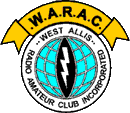
Radio Amateur Club
A Non-Profit Educational Organization

Back
 |
West Allis Radio Amateur Club A Non-Profit Educational Organization |
 Back |
Mobile TipsBy Jim Callow, K8IROperator of NG9T/m |
|
Iíve been active in contesting since I got back into amateur radio in 1997. Since then, Iíve accumulated a bit of wallpaper and a very few plaques. Each time I did well enough to receive a plaque I noticed a lot of luck was involved, especially when it comes to propagation. But you have to be prepared to take advantage of whatever hand the propagation gods hand you. My first attempt at mobile contesting was inspired by an NCJ article by Jim Stahl, K8MR, and was the 2002 Michigan QSO Party. Iíve gone mobile in Michigan every year since, and did a few trips in WIQP along the way. That first year I learned the golden rule of mobile contesting in our second county when my IC706 blew itís finals. Fortunately I had brought along my TS570 as a backup, and we were quickly back on the road. I always try to travel with a backup for everything from rigs to antennas to computers, and the cables that connect them. Fortunately, weíve rarely had to resort to the backup equipment, but you sure are glad itís there when needed. A few other things Iíve learned over the years: You need to be able to quickly QSY from band to band and mode to mode. We now travel with antenna for each band in place and easily switched on line. Mobile antennas are inefficient by their nature, and more so on the lower bands. Whatever you can do to increase that efficiency helps. On 40 and 80 I run modified Hustlers with a DX Engineering top hat, which allows you to use a smaller resonator. I use a 30 meter resonator on 40 and a 60 meter resonator on 80. The theory is to have a more uniform current along the radiating mast. I also try to make sure they are resonant at the frequencies Iím working. I try not to use a tuner, although I have one in line just in case. That being said, I also have learned that propagation has far more to do with how loud you are when mobile than the antenna. There have been years that Iíve worked coast to coast on 80 CW in the MIQP (which goes to midnight), and there have been other years where due to propagation and QRN, it seemed nobody could hear me at night on 80. You quickly find out how much easier it is to be heard on CW than SSB when mobile in contest conditions. Thus most of the mobiles will spend as much time as they can on CW. Itís all about rate. The best part of being mobile is you get that fresh pileup every time you cross the county line. There is a core of stations that will follow you from county to county, and the more counties you work, the more times you can put a quick 25 to 30 QSOís in the log. I spend a lot of time designing a route to maximize the number of counties we can activate in the contest period. The mobileís biggest enemy is the power line. The lines along rural roads are often terribly noisy for miles. Sometimes youíll run into an area where you have S9 or better noise, and suddenly you canít hear most of the stations calling. It would be ideal to run the route before the contest to find any troublesome areas, but thatís something Iíve never had the time to do. Do make a note of roads you should try to avoid next time.If youíre blessed with good propagation, itís tough to pull yourself away from the pileups to go hunting mults, but itís important to do. There are always some counties where you have a little extra time. This is when Iíll go searching. Iíve found itís easier to get some of those in-state mults during the day on 80 or 75. There may not be as many stations on the band, but there isnít as much QRM, and itís easier to attract attention with your mobile signal. Once the masses have moved down to 80/75 in the last hour or two, itís much harder to be heard. Iíve always had someone else do the driving for me. They are an essential part of the team. I had several dedicated drivers through the years. Most recently Eric Janssen, KG9GH has been my driver. Eric works with me on fine-tuning the route. Once on the road, he always knows where we are, and how many minutes until the next county line. Thatís important when making strategic decisions about band changes, and whether thereís time to S&P. He also is the one looking out for the county line signs. |